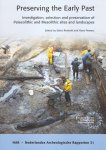RENSINK, EELCO & HANS PEETERS (eds.). - Preserving the Early Pa
| Schrijver: | RENSINK, EELCO & HANS PEETERS (eds.). |
|---|---|
| Titel: | Preserving the Early Past: Investigation, selection and preservation of Palaeolithic and Mesolithic sites and landscapes. |
| Taal: | Engels |
| Uitgever: | ROB Amersfoort |
| Bijzonderheden: | 2006. Illustrated. Stiff wrappers. 226 pp. (Nederlandse Archeologische Rapporten, 31). |
| Beschikbaar: | 13 exemplaren |
| Prijs: | € 9,50 (Excl. verzendkosten) |
| Meer info: |
In the spring of 2001, the National Service for Archaeological Heritage in the Netherlands and the Netherlands School of Archaeological Research (ARCHON) organised a three-day international symposium on early prehistoric archaeology and archaeological heritage management (AHM), entitled ‘Preserving the Early Past. Investigation, selection and preservation of Palaeolithic and Mesolithic sites and landscapes’.
The symposium was held from 20 to 22 November 2002 at the headquarters of the National Service for Archaeological Heritage in the Medieval town of Amersfoort. During the first two days, 18 invited speakers – all archaeologists working in different countries in northwestern Europe and actively involved in Palaeolithic and/or Mesolithic archaeology and AHM – presented a variety of topics related to the central theme of the symposium: the investigation and management of the Palaeolithic and Mesolithic cultural heritage. In addition to the invited speakers, approximately 60 professional archaeologists and students attended the symposium. A field excursion was held on 22 November. Participants travelled to the province of Flevoland for a demonstration of mechanical borings and visited nature conservancy group Stichting Gooisch Natuurreservaat in Hilversum to discuss a large collection of quartzite artefacts from the surface of an ice-pushed ridge in the vicinity of Hilversum. There were a number of reasons for organising this international symposium. In the Netherlands, Palaeolithic and Mesolithic sites have long been a rather neglected part of the archaeological record in AHM.The number of legally protected prehistoric hunter-gatherer sites is low compared to archaeological sites dating from late prehistory or the Roman period, for example. The number of sites protected by law is also manifestly in inverse proportion to the large number of Palaeolithic and Mesolithic sites presently known in the Netherlands. The fact that Palaeolithic and Mesolithic sites are not visible in the Dutch landscape (in contrast to later prehistoric phenomena like terpen, hunebedden and burial mounds) and thus have no aesthetic value, may well be one of the reasons for this discrepancy. Furthermore, until recently virtually all the known Palaeolithic and Mesolithic sites were in the higher, well-drained Pleistocene sandy and loess soils of the Netherlands. Almost all of them are surface sites in a poor state of preservation, and have consequently not been considered serious candidates for in situ preservation. Last but not least, in recent decades only a few Dutch archaeologists have focused their attention on issues associated with the in situ preservation of Palaeolithic and Mesolithic remains. Since the reasons mentioned above, or at least some of them, are also likely to apply to other countries in northwestern Europe, an international symposium on the subject seemed like a useful idea. In many European countries the early prehistoric record now deserves full attention, taking into account the new demands set by the ‘European Convention on the Protection of the Archaeological Heritage (Revised)’ which was signed at Valletta on the island of Malta in 1992. The incorporation of the Malta Convention into Dutch legislation (which is expected in 2006), for instance, requires a strong and comprehensive national policy, a major part of which should deal with Palaeolithic and Mesolithic sites and landscapes.Without such a policy, the loss of archaeological evidence – ranging from very small sites represented by a few stone artefacts to entire buried palaeolandscapes containing archaeological and palaeoenvironmental data – will continue and perhaps even increase as a result of planning processes. The primary objective of the symposium was to learn about the role of Palaeolithic and Mesolithic sites and landscapes in AHM from archaeologists working in various countries in northwestern Europe and to exchange ideas about how to investigate, assess, select and preserve this fragile archaeological resource in various environmental settings.What strategies are appropriate for the detection of Palaeolithic and Mesolithic sites and landscapes, and how do we assess their information value? What scientific criteria should we use as a basis for deciding whether to go ahead with preservation in situ or excavation, or take no action at all? And what potential and constraints do we face in terms of the conservation and sustainable development of these Palaeolithic and Mesolithic remains? The symposium offered an opportunity to discuss these important questions with an international forum of archaeologists, making use of examples from daily practice in the Netherlands, Belgium, France, England and Germany. This volume includes the papers presented and the main conclusions of the discussions as summarized by the chairmen (Barton, Roebroeks and Zvelebil) of three sessions of the symposium. In retrospect, we can conclude that the symposium provided a sound basis for the further development and improvement of management strategies for early prehistoric remains. As an integral part of the archaeological record, and threatened by all kind of interventions in the soil, it is evident that these remains should be treated according to the principles of the Malta Convention and with the same attention given to archaeological remains from later periods. In other words, Palaeolithic and Mesolithic sites and landscapes deserve full consideration in planning processes, with the aim of preservation in situ or – if preservation is not possible – conservation ex situ through excavation. Symposia such as the one held in Amersfoort in 2002 allow us to continue the international debate on issues associated with the management of the Palaeolithic and Mesolithic cultural heritage. However, appropriate management strategies are not the only prerequisite. Problem-oriented research and public awareness will be essential in the battle to protect valuable Palaeolithic and Mesolithic sites and landscapes from further destruction in the near future. And one final point worthy of our attention: not all Palaeolithic and Mesolithic landscapes are equally suited to long-term preservation, even if they have the same intrinsic or physical quality. The potential offered by specific regulations, the attitude and intentions of landowners and land users, and considerations of a practical and financial nature also play an important role in determining whether preservation in situ is possible. It is equally important that we have a thorough understanding of the present qualities of an archaeological site or landscape and whether these qualities can be maintained in the long term. It does not make much sense to preserve an archaeological site on scientific grounds if one is unable to prevent it from further disturbance due to slope erosion or ploughing, for instance. If the quality of a site is likely to significantly decline over the years, excavation in advance of further destruction should be given preference over preservation. |

De verkoper zal binnen 3 werkdagen contact met u opnemen om de koop verder af te handelen.
Het huisnummer is ook opgegeven in het straat veld. Gelieve controleren of de velden straat en huisnummer correct zijn opgegeven.
Straat:
Nummer:
- Alle boeken zijn compleet en verkeren in normale antiquarische staat, tenzij anders beschreven. Kleine onvolkomenheden, zoals een ingeplakte ex-libris of een naam op het schutblad, zijn niet altijd vermeld
- U handelt deze order direct af met boekenkeldertje
Deze verkoper is een particulier, dit heeft invloed op welke rechten voor u als koper ontbreken. Zo heeft u geen herroepingsrecht of conformiteitsrecht. Verder lezen. - Na uw bestelling ontvangen u en boekenkeldertje een bevestiging per e-mail. In de e-mail staan de naam, adres, woonplaats en telefoonnummer van boekenkeldertje vermeld
- De Koper betaalt de verzendkosten, tenzij anders overeen gekomen
- boekenkeldertje kan betaling vooraf vragen
- Boekwinkeltjes.nl probeert Kopers en Verkopers tot elkaar te brengen. Boekwinkeltjes.nl is echter nimmer partij bij een overeenkomst die gesloten wordt tussen Koper en Verkoper door gebruikmaking van de site. Als u een geschil hebt met één of meer gebruikers, dient u dit zelf op te lossen. U vrijwaart Boekwinkeltjes.nl van enigerlei vorderingen, aanspraken op schadevergoeding en dergelijke, verband houdende met dergelijke geschillen.
Onthoud mijn gegevens
Registreer u vrijblijvend als koper!
Besteld, hoe nu verder?
De verkoper zal binnen 3 werkdagen contact met u opnemen om de koop verder af te handelen. Afhankelijk van uw locatie heeft u in de meeste gevallen binnen 2 dagen uw bestelling in huis.


